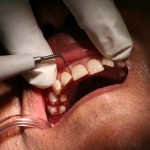
Moderate to severe periodontal disease affects more than 30% of people. Professional mechanical plaque removal (PMPR) which includes, scale and polish, and oral prophylaxis but not root planning or root surface debridement is regularly prescribed for the management of periodontal disease.
The aim of this review was to assess the effect of PMPR on clinical and patient reported outcomes related to the primary prevention of periodontal diseases in adults. The review is an update of a 2005 review by Needleman et al.
Methods
Searches were conducted in The Cochrane Central Register of Controlled Trials (CENTRAL), Medline and Embase databases. Two reviewers independently selected studies, abstracted data and assessed risk of bias. Randomised controlled trials (RCTs) of Professional plaque removal with a comparison group of no intervention, oral hygiene instruction only or different frequencies of professional mechanical plaque removal were considered.
Results
- 3 studies were included.
- Risk of bias was unclear of high in all 3 studies.
- 3 studies compared PMPR + Oral Hygiene Instruction (OHI) versus no treatment and found evidence for PMPR+OHI achieving more favourable changes in plaque and bleeding/ inflammation compared with no treatment. There was no available evidence for an effect on Pocket depth (PD) or attachment level (AL).
- 2 studies compared PMPR + OHI versus OHI and found Evidence suggesting no difference between PMPR+OHI and OHI alone in maintaining or improving plaque and bleeding outcomes.
- There was no additional information from other intervention comparisons in the 3 studies.
- Evidence from the 3 new studies was considered with existing RCT evidence.
Conclusions
The authors concluded:
Low–moderate strength of evidence suggests that in adults, PMPR, particularly if combined with OHI, may achieve greater changes in measures of dental plaque and gingival bleeding/ inflammation than no treatment.
Moderate strength of evidence suggests there is no additional benefit to plaque and gingival bleeding outcomes from PMPR over that achieved by repeated and thorough oral hygiene instructions although with no evidence to inform on prevention of periodontitis.
Low strength of evidence suggests that more frequent PMPR is associated with improved plaque and bleeding outcomes and possibly less annual attachment loss.
Comments
As noted above this review is an update of an earlier review published in 2005. That earlier review searched the literature from 1950 to 2004 and included 32 relevant studies. This review slightly strengthens the evidence that there is little value in providing PMPR without OHI. However, in the past decade it is disappointing that there has been little quality research conducted on this highly prevalent condition, which has important impacts on quality of life.
Also related is the recently updated Cochrane Review (Dental Elf -20th Nov 2013), noted by the authors. This review focuses more narrowly on scale and polish and only included 3 studies finding that there was, ‘insufficient evidence to determine the effects of routine scale and polish treatments.’
Links
Needleman I, Nibali L, Di Iorio A. Professional mechanical plaque removal for prevention of periodontal diseases in adults – systematic review update. J Clin Periodontol. 2015 Apr;42 Suppl 16:S12-35. doi: 10.1111/jcpe.12341. PubMed PMID: 25495962
Needleman I, Suvan J, Moles DR, Pimlott J. A systematic review of professional mechanical plaque removal for prevention of periodontal diseases. J Clin Periodontol. 2005;32 Suppl 6:229-82. Review. PubMed PMID: 16128841.
Dental Elf – 20th Nov 2013 – Insufficient evidence to determine the effects of routine scale and polish treatment

Don’t miss – Professional plaque removal more effective with oral hygiene instruction http://t.co/QXdGPrXvZP #EBP
Prof Needleman
Has quite rightly pointed out that we should clarify for those readers who are not quite so familiar with management of periodontal diseases. ‘PMPR is not used for treatment of chronic periodontitis but only for treatment of gingivitis and prevention of periodontitis’
Professional plaque removal needs OHI – new comment http://t.co/RtFUliVMoi
[…] Dental Elf – 13th April 2015 – Professional plaque removal more effective with oral hy… […]